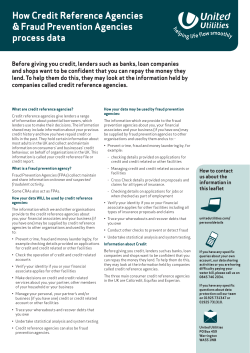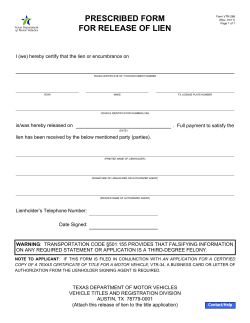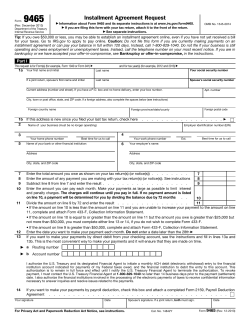
How to Read an Equifax Credit Report June 2014 FADV0037
How to Read an Equifax Credit Report June 2014 FADV0037 CONFIDENTIAL & PROPRIETARY The recipient of this material (hereinafter "the Material") acknowledges that it contains confidential and proprietary data the disclosure to, or use of which by, third parties will be damaging to First Advantage. Therefore, recipient agrees to hold the Material in strictest confidence, not to make use of it other than for the purpose for which it is being provided, to release it only to employees requiring such information, and not to release or disclose it to any other party. Upon request, recipient will return the Material together with all copies and modifications, if any. All names in the text, or on the sample reports and screens shown in this document, are of fictitious persons and entities. Any similarity to the name of any real person, address, school, business or other entity is purely coincidental. The First Advantage logo is a registered trademark of First Advantage, used under license. Other products and services may be trademarks or registered trademarks of their respective companies. Copyright ©2014, First Advantage. All rights reserved. Table of Contents Introduction ..................................................................................................................... 1 About this document......................................................................................................... 1 Credit Report Sections ...................................................................................................... 2 Identification Information Section .................................................................................................................. 2 Identity Scan Warning Section ....................................................................................................................... 3 Report Summary Section .............................................................................................................................. 3 Public Records Section.................................................................................................................................. 5 Bankruptcy ............................................................................................................................................. 5 Judgment ............................................................................................................................................... 6 Tax Lien.................................................................................................................................................. 7 Collection Information Section....................................................................................................................... 8 Trades Section ............................................................................................................................................ 9 Inquiries Section ........................................................................................................................................ 11 Messages Section ...................................................................................................................................... 11 Consumer Statement and Consumer Assistance Contact Sections ...................................................................... 11 Appendix A: Sample of Equifax Credit Report.................................................................... 12 Appendix B: Codes and Description .................................................................................. 15 ECOA Codes ............................................................................................................................................. 15 Portfolio Types.......................................................................................................................................... 15 Rate/Status Codes used in Payment History ................................................................................................... 16 How to Read an Equifax Credit Report FADV0037 June 2014 Introduction An Equifax Credit Report provides information about the financial history of an individual. This report helps you to predict possible risk stemming from financial problems that can lead to failure in maintaining property or cause distractions, which may lead to the submission of fictitious claims or inflated legitimate claim amounts. Note: The sections in this report appear based on the subject’s financial history. For example, if a subject has no Public Records/Legal Items on record, that section will not appear in the report. About this document This document explains how to read and interpret the information present in an Equifax Credit Report. This document includes screenshots from a sample report and contains fictitious information. Copyright © 2014 First Advantage. All rights reserved. 1 How to Read an Equifax Credit Report FADV0037 June 2014 Credit Report Sections Identification Information Section This section displays information about the subject including name, SSN, and addresses. 1) File Date – The date when the records were obtained through Equifax 2) FILE SINCE – The date the file was established 3) File Activity Date – The date of most recent activity on file 4) Applicant Provided SSN – Social Security Number provided by the subject 5) SSN Match – Indicates if the SSN provided by the subject matches with the SSN present in the Equifax database 6) Inquiry SSN Issued Date – The date when the SSN was issued 7) Inquiry SSN Issued State – The state where the SSN was issued 8) SUBJECT NAME – Name of the subject 9) FORMER NAMES – Other names of the subject 10) CURRENT ADDRESS – Current address of the subject 11) First Reported – Year and month when the subject started residing at this address 12) Last Reported – The date when the subject stopped residing at this address 13) FORMER ADDRESS(ES) – Former addresses of the subject Copyright © 2014 First Advantage. All rights reserved. 2 How to Read an Equifax Credit Report FADV0037 June 2014 Identity Scan Warning Section This section displays warnings related to the subject’s identity. Report Summary Section This section displays payment history. 1) PUBLIC RECORDS – The total number of public records present on file 2) COLLECTIONS – The total number of collection agency accounts present on file 3) ACCTS – The total number of trade line accounts present on file 4) HIGH CREDIT RANGE – Highest credit range present on file 5) MOP RATES – Manner of Payment Rates. This may include the below fields: a. Too new to rate; Approved but not used b. Pays account as agreed c. Not more than two payments past due d. Not more than three payments past due e. Not more than four payments past due f. At least 120 days or more than four payments past due g. Collection account h. Included in Chapter 13 i. Repossession j. Charge-off k. Other Copyright © 2014 First Advantage. All rights reserved. 3 How to Read an Equifax Credit Report FADV0037 June 2014 6) RATE HIST – This provides a summary of historical delinquencies. This may also include additional fields listed in MOP Rates. a. Not more than two payments past due b. Not more than three payments past due c. Not more than four payments past due d. At least 120 days or more than four payments past due e. Collection account f. Repossession g. Charge-off Copyright © 2014 First Advantage. All rights reserved. 4 How to Read an Equifax Credit Report FADV0037 June 2014 Public Records Section This section displays details about the subject’s public records information on file with Equifax. This may include Bankruptcy, Judgment, or Tax Lien. Bankruptcy This section displays the subject’s Bankruptcy details. 1) This indicates the type of public record a. Bankruptcy b. Judgment c. Tax Lien 2) COURT CUST NUM – The customer number assigned by the court 3) FILING DATE – The date when the bankruptcy was filed or reported 4) TYPE – Type of filing (Individual or Business) 5) HOW FILED – How the bankruptcy was filed (individual, joint, or spouse) 6) CASE NUMBER – Number assigned to the case 7) DISP DATE – The date of disposition 8) CURRENT INTENT / DISP – Type of bankruptcy and description 9) PRIOR INTENT – Prior type of bankruptcy Copyright © 2014 First Advantage. All rights reserved. 5 How to Read an Equifax Credit Report FADV0037 June 2014 Judgment This section displays the subject’s Legal Item (judgment) details. 1) Type of public record 2) COURT CUST NUM – The customer number assigned by the court 3) FILING DATE – The date when the legal item was filed or reported 4) TYPE – The type of judgment given by the court 5) AMOUNT – The amount owed by the subject 6) DATE SATISFIED – The date when the legal item was satisfied 7) CASE NUMBER – Number assigned to the case 8) STATUS – Current status of the legal item 9) DATE VERIFIED – The date when the information was verified 10) Consumer Narrative – This indicates specific account conditions Copyright © 2014 First Advantage. All rights reserved. 6 How to Read an Equifax Credit Report FADV0037 June 2014 Tax Lien This section displays the subject’s Legal Item (judgment) details. 1) Type of public record 2) COURT CUST NUM – The customer number assigned by the court 3) FILING DATE – The date when the tax lien was filed or reported 4) CLASS – Creditor classification 5) AMOUNT – The amount of the lien 6) DATE RELEASED – The date when the lien was released 7) CASE NUMBER – Number assigned to the case 8) LIEN STATUS – Current status of the lien 9) DATE VERIFIED – The date when the information was verified Copyright © 2014 First Advantage. All rights reserved. 7 How to Read an Equifax Credit Report FADV0037 June 2014 Collection Information Section This section displays details about the subject’s collection information on file with Equifax. 1) DATE REPORTED – The date when the collection was reported 2) AGENCY NUMBER – The collection agency’s number 3) CLIENT – Collection agency’s client name 4) DATE ASSIGNED – The date when the collection was assigned 5) ECOA – Account designator (see Appendix B for a list of ECOA Codes) 6) STATUS – The status of the collection 7) DATE FIRST DELINQ – The date of the first delinquency 8) AMOUNT OWED – The amount the subject originally owed 9) CLASS – Creditor classification 10) DATE LAST PYMT – The date when the last payment was made 11) BALANCE OWED – The balance owed by the subject Copyright © 2014 First Advantage. All rights reserved. 8 How to Read an Equifax Credit Report FADV0037 June 2014 Trades Section This section displays details about the subject’s trade activities. 1) CREDITOR NAME – This indicates the name of the creditor 2) MEMBER NUM – Equifax member number for the creditor 3) PORTFOLIO TYPE – This field displays the portfolio type. See Appendix B for a full listing of Portfolio Types. 4) DATE RPTD – The date when the account was last reported 5) DATE OPENED – The date when the account was originally opened 6) DATE CLOSED – The date when the account was originally closed 7) ECOA – Account designators (see Appendix B for a list of ECOA Codes) 8) RATE / STATUS – Rate and status of the account 9) DFD/DLA – Date of First Delinquency or Date of Last Activity 10) HIGH CREDIT – Highest outstanding balance or the original amount 11) CREDIT LIMIT – Highest available credit limit 12) BALANCE AMT – The account balance 13) PAST DUE AMT – The past due amount 14) LAST PYMT – The date when the most recent payment was done 15) MAJ DEL – The date when the major delinquency was first reported 16) ACCT TYP – This indicates the type of account held. Examples of types of accounts: a) Auto b) Lease Copyright © 2014 First Advantage. All rights reserved. 9 How to Read an Equifax Credit Report FADV0037 June 2014 c) Auto Lease d) Unsecured e) Credit Card f) Home Improvement g) Mortgage Identification Number (if real estate) h) Debt Buyer Account i) Charge Account j) Education Loan 17) ACT PYMT – The actual payment amount 18) SCH PYMT – The scheduled payment amount 19) ACCT STATUS – The status of the account a) Paid and Closed b) Closed c) Transfer/Sold/Paid d) Lost/Stolen e) Paid f) Refinanced g) Transfer/Sold 20) CHARGE OFF AMT – The charge-off amount 21) BALLOON AMT – The balloon payment amount 22) 30 DAY DEL – The number of times the subject was late by 30 days 23) 60 DAY DEL – The number of times the subject was late by 60 days 24) 90 DAY DEL – The number of times the subject was late by 90 days 25) PYMT HST – Payment history on the account for last 24 months See Appendix B for a full listing of Rate/Status Codes used in Payment History 26) Comments Section – Final comment on the trade account Copyright © 2014 First Advantage. All rights reserved. 10 How to Read an Equifax Credit Report FADV0037 June 2014 Inquiries Section This section displays the details of credit inquiries (request for a credit report) on this subject and provides the company name, member ID, and the inquiry date. Messages Section This section provides messages related to the subject or his/her account verification. Consumer Statement and Consumer Assistance Contact Sections This section provides a disclaimer to the subject and the Equifax contact information. Copyright © 2014 First Advantage. All rights reserved. 11 How to Read an Equifax Credit Report FADV0037 June 2014 Appendix A: Sample of Equifax Credit Report Copyright © 2014 First Advantage. All rights reserved. 12 How to Read an Equifax Credit Report FADV0037 Copyright © 2014 First Advantage. All rights reserved. June 2014 13 How to Read an Equifax Credit Report FADV0037 Copyright © 2014 First Advantage. All rights reserved. June 2014 14 How to Read an Equifax Credit Report FADV0037 June 2014 Appendix B: Codes and Description ECOA Codes Codes Description ATH USR or A Authorized user BEHALF or B On behalf of another person CO MAKR or C Co-Maker INDIVID or I Individual account JOINT or J Joint account MAKER or M Maker SHARED or S Shared TERMNTD or T Terminated UNDESIG or U Undesignated Portfolio Types Code Description C Line of Credit (payment amounts based on the outstanding balance) I Installment (fixed number of payments) M Mortgage (fixed number of payments—usually for real estate) O Open account (entire balance is due upon demand) R Revolving (payment amounts based on the outstanding balance) Blank No Portfolio type available Copyright © 2014 First Advantage. All rights reserved. 15 How to Read an Equifax Credit Report FADV0037 June 2014 Rate/Status Codes used in Payment History Code Blank Description Not populated based on the Date Open (payment history will only be populated for each of the months that the account has been open) * (asterisk) Rate/Status was not available for that month 0 Too New to Rate; Approved but not used 1 Current account; paid as agreed 2 Pays 30-59 days past due; not more than 2 payments past due 3 Pays 60-89 days past due; not more than 3 payments past due 4 Pays 90-119 days past due; not more than 4 payments past due 5 Pays 120 or more days past due; more than 4 payments past due 6 Collection account 7 Included in Chapter 13 bankruptcy 8 Repossession or foreclosure 9 Charged Off account E Zero balance and current account Copyright © 2014 First Advantage. All rights reserved. 16
© Copyright 2025















